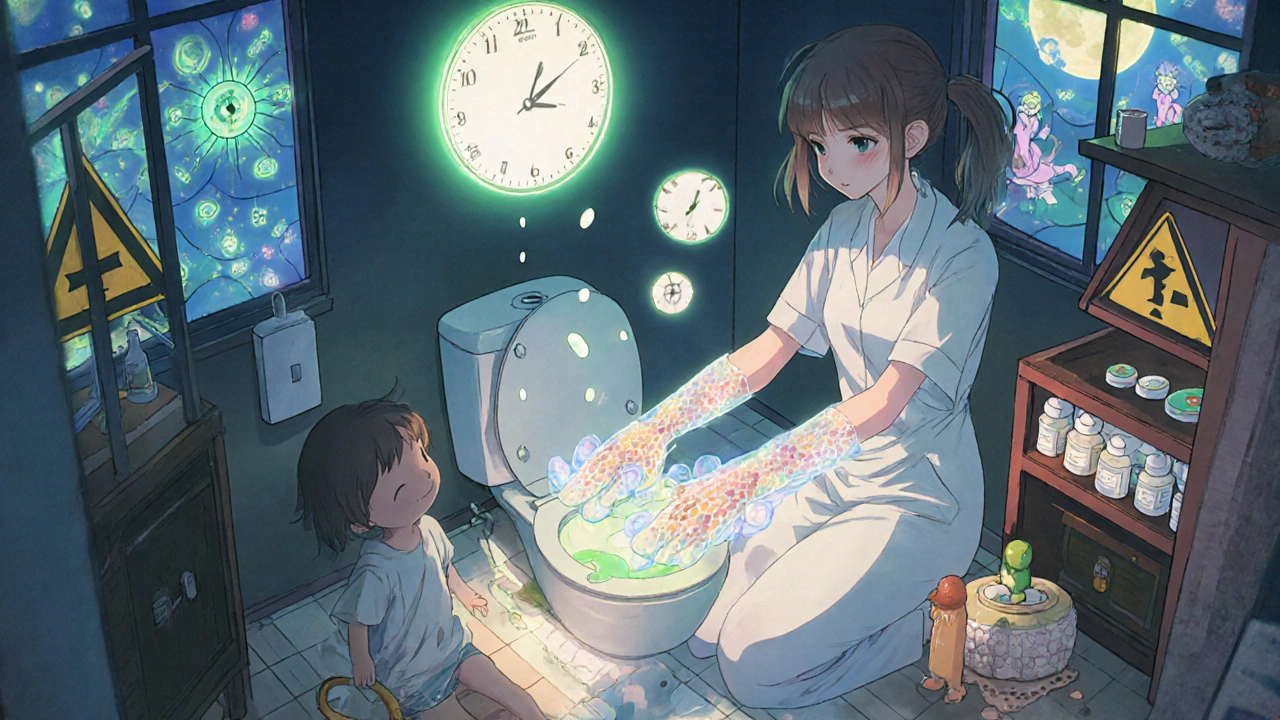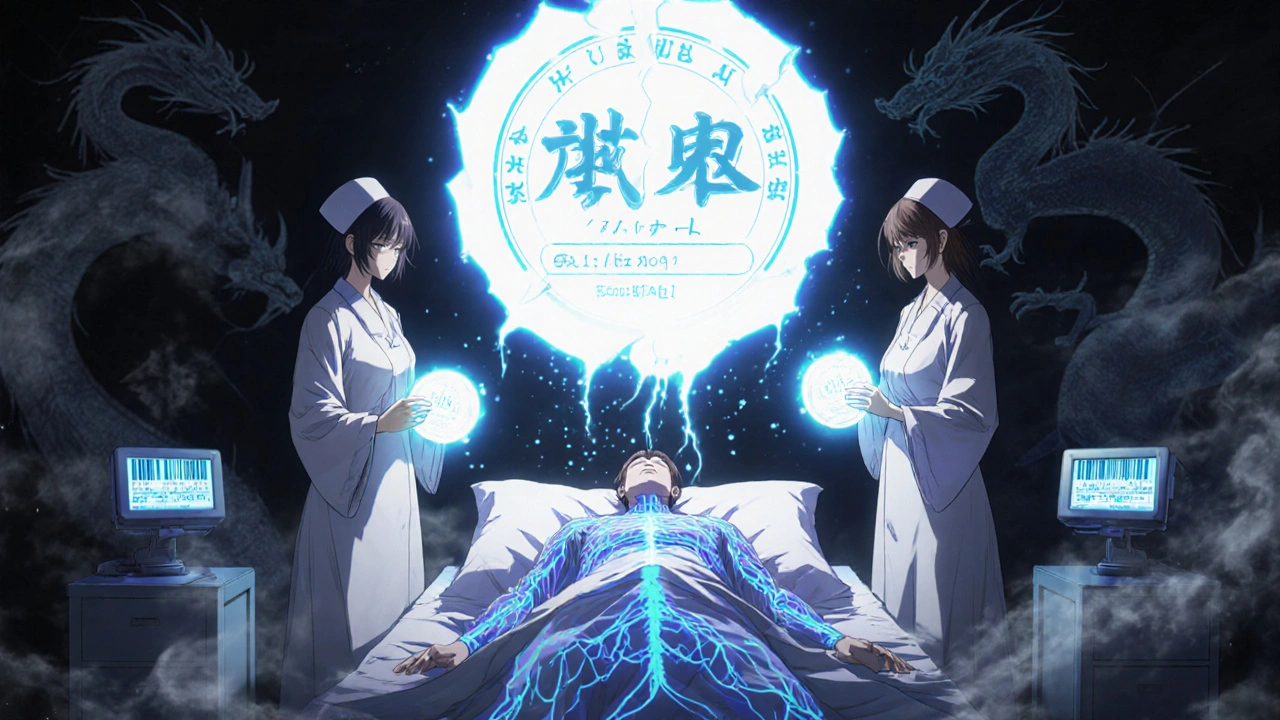Why Chemotherapy Safety Isn’t Just About the Patient
Chemotherapy drugs don’t just target cancer cells. They can damage healthy tissue-and if handled wrong, they can harm the people giving them. Nurses, pharmacists, caregivers, and even family members are at risk from exposure to these potent drugs. It’s not a matter of "if" something goes wrong-it’s a matter of "when," unless strict safety steps are followed. The 2024 update to the ASCO/ONS Antineoplastic Therapy Administration Safety Standards made one thing clear: safety isn’t optional. It’s mandatory. And it starts long before the drug touches the patient’s vein.
The Four Pillars of Safe Chemotherapy Administration
The current standards break down safety into four non-negotiable areas. Skip any one, and you’re increasing risk-for everyone involved.
- Safe Environment: Every facility that handles antineoplastic drugs must have proper engineering controls. This includes closed-system transfer devices (CSTDs) that prevent drug aerosols from escaping during mixing, and dedicated ventilation systems to pull contaminated air away from staff. Surfaces must be non-porous and easy to decontaminate. No more using the same counter for pills and chemo.
- Patient Consent and Education: Before treatment begins, patients must be told exactly what drug they’re getting, why, how long it will last, and what side effects to watch for. This isn’t a formality-it’s a legal and ethical requirement. Documentation must be signed, dated, and stored. Patients who understand their treatment are less likely to miss doses or ignore warning signs.
- Ordering, Preparing, and Dispensing: Every step from prescription to syringe must be double-checked. The 2024 update added a critical new step: a fourth verification done at the patient’s bedside. Two licensed clinicians must confirm the patient’s name, date of birth, drug name, dose, route, and time using two separate identifiers. This step alone cut patient identification errors by nearly half in early adopter clinics.
- Monitoring During and After: Some drugs, especially newer immunotherapies, can trigger cytokine release syndrome (CRS)-a dangerous immune overreaction. Facilities must have antidotes like tocilizumab on hand and staff trained to recognize early signs: fever, low blood pressure, trouble breathing. Waiting until the patient is in crisis is no longer acceptable.
What Personal Protective Equipment (PPE) Is Actually Required
Wearing gloves isn’t enough. You need the right gloves. The ASCO/ONS standards specify chemotherapy-tested double gloves-not just any latex or nitrile. These gloves are tested to resist permeation by specific drugs like carmustine and thiotepa, which can seep through regular gloves in under 10 minutes. The outer glove must be changed every 30 minutes or immediately if torn.
Eye protection is required whenever splashing is possible. Gowns must be impermeable, not just fluid-resistant. And if you’re dealing with powders or aerosols-like when opening vials or cleaning spills-you need a respirator. NIOSH-certified N95s or better. Not a surgical mask.
Here’s what you don’t do: reuse gloves. Don’t wear the same gown to the break room. Don’t touch your phone, door handles, or face with contaminated gloves. Studies from 1992 to 2020 show that contamination transfers from gloves to skin, then to surfaces, then to other people. One nurse touched a doorknob after handling cyclophosphamide. Three hours later, her coworker touched the same knob-and tested positive for the drug on her skin.
Home Chemotherapy: The Hidden Risk Zone
More patients are getting chemo at home now. That’s good for quality of life-but dangerous if caregivers aren’t trained. The American Cancer Society reports that 22% of home-based incidents involve improper disposal of bodily fluids. Urine, vomit, and sweat can contain active drug particles for up to 72 hours after treatment.
Here’s what families need to know:
- Wear gloves when handling soiled linens or cleaning the toilet.
- Flush the toilet twice after use.
- Use dedicated, clearly labeled containers for sharps-never regular trash.
- Store all medications out of reach of children and pets, preferably locked.
- Keep a chemotherapy spill kit in the home, with absorbent pads, gloves, and disposal bags.
Facilities that use the ASCO-developed "Chemotherapy Safety at Home" toolkit report a 41% drop in caregiver anxiety and mistakes. But too many patients get a pamphlet and are sent home. That’s not education. That’s negligence.

The Real Cost of Getting It Right (and Wrong)
Implementing full safety protocols isn’t cheap. A medium-sized clinic needs $22,000-$35,000 for facility upgrades, $8,500-$12,000 for staff training, and $4,200-$6,800 annually for PPE and waste disposal. CSTDs alone can cost $5,000-$15,000 per unit.
But the cost of not doing it? Higher.
Facilities with full compliance see 63% fewer medication errors and 78% fewer occupational exposures. OSHA issued 142 citations in 2022 for hazardous drug violations-with an average fine of $14,250 per violation. And that’s just the fines. The real cost is in lost staff, lawsuits, and patient harm.
One hospital in Ohio paid $1.2 million in settlement after a nurse developed leukemia linked to long-term, unreported exposure to ifosfamide. She never wore a gown. The facility didn’t have CSTDs. The paperwork said she did.
What’s Changing in 2025 and Beyond
The National Comprehensive Cancer Network (NCCN) will start requiring proof of the fourth verification step and CRS protocols for facility accreditation starting January 2025. That means clinics without these systems will lose their accreditation-and their Medicare reimbursement.
AI-powered verification systems are being piloted at 12 NCI-designated centers. These tools scan barcodes on drugs and patient wristbands, then cross-check with the electronic record. If something doesn’t match, the system won’t allow administration. Early results show a 60% reduction in manual verification time.
By 2026, a national certification for chemotherapy administration may become mandatory. Right now, training varies wildly. Some nurses get 4 hours. Others get 12. That’s not fair to patients or providers.
Why the Fourth Verification Step Matters More Than You Think
Dr. Gary H. Lyman, lead author of the 2024 standards, says the biggest cause of chemotherapy-related harm isn’t toxicity-it’s misidentification. In 2022, 18% of adverse events reported to the NCCN database were due to giving the wrong drug to the wrong patient.
That’s not a rare mistake. It’s systemic. One nurse gave paclitaxel to a patient who was supposed to get cisplatin. The patient went into cardiac arrest. She survived-but with permanent nerve damage.
The fourth verification isn’t about bureaucracy. It’s about stopping that moment before it happens. Two people look at the same ID. Two people say the same name. Two people confirm the dose. That’s the safety net.

What’s Not Being Said: The Equity Gap
Dr. Sarah Temkin’s 2022 analysis in the Journal of Oncology Practice exposed a dark truth: safety standards aren’t equal. Rural clinics, small community hospitals, and safety-net facilities can’t afford CSTDs, dedicated ventilation, or full-time safety officers. Forty-three percent of rural programs can’t meet the full CSTD requirement.
That means patients in those areas are getting the same drugs-but with less protection. The nurses are doing their best. But they’re working with outdated equipment, shared spaces, and no backup. This isn’t just a logistics problem. It’s a justice problem.
Until funding and policy catch up, the safest chemotherapy care will be available only to those who live near major cancer centers. Everyone else is playing Russian roulette with their health.
What You Can Do Today
If you’re a patient: Ask your nurse or pharmacist: "Do you use double gloves? Do you have a CSTD? Do you do a bedside verification?" If they don’t know, or say "We’ve always done it this way," push for answers.
If you’re a caregiver: Get the ASCO home safety toolkit. Practice spill cleanup. Learn where to dispose of sharps. Don’t assume someone else will handle it.
If you’re a provider: Audit your PPE. Check your CSTDs. Make sure your EHR supports the fourth verification. Train your staff. Don’t wait for an OSHA inspection to wake you up.
Safety isn’t a checklist. It’s a culture. And it starts with one person refusing to cut corners.
Can chemotherapy drugs harm caregivers at home?
Yes. Chemotherapy drugs can remain active in bodily fluids like urine, vomit, and sweat for up to 72 hours after treatment. Without proper precautions-like wearing gloves when cleaning, flushing the toilet twice, and using dedicated disposal containers-caregivers can be exposed. Studies show 22% of home incidents involve improper waste handling, and 17% involve uncontrolled spills.
Do I need special gloves for handling chemotherapy?
Yes. Regular exam gloves are not enough. You need chemotherapy-tested double gloves that have been proven to resist permeation by specific drugs like carmustine and thiotepa. The outer glove must be changed every 30 minutes or immediately if torn. Studies show regular gloves can allow drug penetration in under 10 minutes.
What is the fourth verification step in chemotherapy administration?
The fourth verification is a mandatory bedside check performed just before giving chemotherapy. Two licensed clinicians must independently confirm the patient’s identity using two identifiers (like name and date of birth), match the drug, dose, route, and time to the prescription, and visually verify the medication label. This step was added in 2024 to prevent fatal misidentification errors, which caused 18% of chemotherapy-related adverse events in 2022.
Are all cancer centers required to follow these safety standards?
Not yet by law, but compliance is becoming mandatory for reimbursement. The National Comprehensive Cancer Network (NCCN) will require proof of full adherence-including the fourth verification and CRS protocols-for facility accreditation starting January 2025. Medicare and Medicaid reimbursement may be tied to this accreditation. OSHA also enforces penalties for violations, with 142 citations issued in 2022 alone.
What should I do if I suspect a chemotherapy spill?
Never clean a spill with bare hands or a regular towel. Use a chemotherapy spill kit, which includes impermeable gloves, absorbent pads, a sharps container, and sealed disposal bags. Contain the spill, put on PPE, then carefully absorb and dispose of all materials. All contaminated items must be labeled as hazardous waste. Afterward, wash surfaces with detergent and water, then test for contamination if possible. Facilities should have a written spill response plan-and staff should be trained on it annually.
Why are closed-system transfer devices (CSTDs) important?
CSTDs prevent hazardous drugs from escaping into the air during mixing, transferring, or disposal. They reduce inhalation and skin exposure risks for staff. Studies show CSTDs cut airborne contamination by up to 95%. The European Society for Medical Oncology and NIOSH both recommend them as essential. Yet, 43% of rural U.S. clinics still can’t afford them, creating a safety gap between urban and rural care.
How often should staff be trained on chemotherapy safety?
Initial training must be 8-12 hours and include both written exams (minimum 85% pass rate) and a live skills demonstration. After that, staff must complete 4 hours of annual refreshers. This is required by the 2024 ASCO/ONS standards. Training must cover new drugs, updated PPE protocols, spill response, and the fourth verification process. Skipping refresher training is a violation.
Next Steps for Patients and Providers
If you’re a patient or family member, ask for the ASCO "Chemotherapy Safety at Home" toolkit. If you’re a clinic administrator, audit your PPE inventory, check your CSTD functionality, and verify that your EHR supports the fourth verification step. If you’re a nurse or pharmacist, speak up if your facility lacks resources. Safety isn’t about budget-it’s about ethics. Every person who touches chemotherapy deserves protection. Every patient deserves to be sure they’re getting the right drug, at the right time, in the right way.


Georgia Green
November 16, 2025 AT 20:12just read this and had to pause. my mom got chemo at home and we never got a spill kit. we used paper towels and wore regular gloves. i didn't even know the drugs could stay active in sweat for days. we were lucky nothing happened.
Kathy Grant
November 18, 2025 AT 13:57it's not just about gloves or CSTDs. it's about the culture. i've seen nurses skip double gloves because they're "in a rush." and then they touch their face, then their phone, then their kid's hair. it's not negligence-it's ignorance. and ignorance kills. we need mandatory, visceral training. not a 10-minute slide deck. show them what happens to bone marrow. show them the blood tests. make them feel it.
the fourth verification isn't bureaucracy. it's the last line before someone dies. and if you're the one who skipped it, you'll live with that forever.
we treat cancer like a battle. but the real war is against complacency.
Robert Merril
November 18, 2025 AT 15:59so lets get this straight. we need $15k per CSTD, special gloves, respirators, 12hr training, and now a fourth person to check the name? and you wonder why nurses quit? this is why we have burnout. its not about safety its about liability. and now theyre gonna make us pay for it with our sanity
Christina Abellar
November 19, 2025 AT 02:22thank you for writing this. i wish more people knew how dangerous this really is.
Roberta Colombin
November 20, 2025 AT 06:57i want to say this with care. every person who handles chemotherapy deserves dignity and protection. but we must also remember that not every community has the same resources. the gap between urban and rural care is not just a policy issue-it is a moral one. a nurse in rural kentucky is not less brave than one in boston. she just has less. we must fix the system, not blame the hands that hold it.
let us not forget: safety is not a privilege. it is a right.
Eva Vega
November 21, 2025 AT 12:15the implementation of closed-system transfer devices (CSTDs) aligns with the NIOSH hierarchy of controls by engineering out exposure hazards at the source. without CSTDs, you're relying on administrative controls and PPE-both of which have high failure rates due to human variability. the 95% reduction in airborne contamination is statistically significant (p<0.001) and reproducible across multiple peer-reviewed studies from 2018–2023.
the equity gap is real, but it's also solvable through federal grant allocation under OSHA’s Hazardous Drug Exposure Reduction Program. we need to treat this like we treated lead in paint-systemic, mandatory, funded.
Ashley Unknown
November 22, 2025 AT 06:03you know what they're not telling you? the chemo drugs are being used to control the population. the fact that they're so toxic? it's intentional. the pharmaceutical companies make billions off the side effects. they don't want you to know that the gloves they sell you are barely tested. they're selling fear. and the FDA? they're in the pocket of big pharma. i've seen the leaked emails. they knew about the permeation rates in 2017 and did nothing. the fourth verification? it's a distraction. they want you to think you're safe while the real poison is still in the system. the real danger isn't the drug-it's the system that lets it be handled like this.
why do you think they push home chemo? easier to hide the contamination. easier to blame the caregiver. easier to avoid accountability. and don't even get me started on the AI verification systems-those are just tracking your biometrics. they're building a database. for what? i don't know. but i'm not trusting it.
they told me my mom's cancer was in remission. then she got leukemia. i asked the hospital if it was the chemo. they said "no." i asked for her exposure logs. they said "we don't keep them."
ask yourself-why are they so afraid of the truth?
Dave Feland
November 24, 2025 AT 02:44the 2024 ASCO/ONS guidelines explicitly mandate two-identifier verification, yet the term "fourth verification" is a misnomer. it is not the fourth step-it is the third verification step, with the first being the prescriber, the second the pharmacist, and the third the bedside nurse. the addition of a second independent clinician at the bedside is the fourth verification. this is not semantic nitpicking-it is critical for accurate citation and legal liability. mislabeling procedural steps undermines the integrity of the entire framework. if we cannot be precise about safety, how can we expect it to be implemented?
furthermore, the claim that "43% of rural clinics can't afford CSTDs" ignores the fact that many of these institutions have received federal grants under the Rural Health Initiative, yet still failed to allocate funds appropriately. this is not a funding gap-it is a leadership failure.
Noel Molina Mattinez
November 24, 2025 AT 05:17you guys are overreacting. i work in oncology and we just use regular gloves and wipe down with bleach. no one's gotten sick. stop making it a drama. the patients are the ones who matter not the staff. if you don't like it quit
Marta Carluccio
November 25, 2025 AT 04:33the author of this post is my husband. i'm the one who cleaned up his chemo spills at home for 18 months. i didn't know i was supposed to flush twice. i didn't know about the gloves. i just thought he was tired. i'm sorry i didn't know. i'm sorry i didn't ask. i'm sorry i didn't protect myself. thank you for writing this. i'm getting the toolkit today.